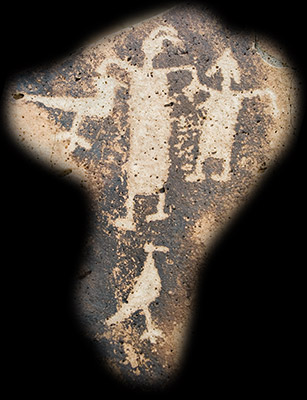


The Santa Fe River starts its journey in the Sangre de Cristo Mountains north of the city of Santa Fe, New Mexico and travels for 42 miles before joining the Rio Grande. As the river leaves the city of Santa Fe to the west, it begins to flow through a canyon that it has eroded between mesas. Petroglyphs are common all along the volcanic escarpment, etched into the desert varnished basalt.
Many refer to petroglyphs as "rock art", but at least some examples have been proven to be a form of writing used by ancient indigenous peoples. Researchers have confirmed this theory by identifying several panels of petroglyphs that depict native American Indian myths or historical events.
The petroglyphs in this area were created by the Anasazi and Pueblo Indians and some may date as far back as 900 AD or earlier. Many of the better preserved petroglyphs have been attributed to the period dating from 1300 to 1500 AD and can be attributed to the Keres Pueblo Indians, some of whose decendants now live on the nearby Cochiti Pueblo Reservation. Since access to the canyon is limited, the majority of petroglyphs are well preserved and free from modern day graffiti. Efforts are currently under way to purchase privately owned property in the area in order to preserve these and other related archeological sites.
Petroglyphs along the river can be found on boulders along the canyon floor all the way up the canyon walls to the tops of the mesas, with the majority on the basaltic rock lining the edges of the mesas.
Whenever you visit any archeological site including petroglyph sites, remember to respect our nation's historical heritage by leaving only foot prints and taking only photographs. That way they will be preserved for many more generations to come. Enjoy the images.